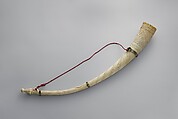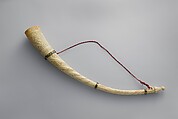Returned to lender The Met accepts temporary loans of art both for short-term exhibitions and for long-term display in its galleries.
Oliphant
Not on view
At least ten Kongo oliphants reached Europe; likely presentation pieces, all lack signs of use. Each carved elephant tusk features a mouthpiece on the inner curve, toward the horn’s upper limit, and suspension lugs, that may show European influence. Delicately inscribed bands of abstract geometric patterns with an array of interlace designs embellish their surfaces in horizontal and diagonally spiraling bands. In Kongo thought, this design scheme of a continuous spiral is a visual metaphor for the path taken through time by the dead. Movement in a spiral trajectory is referenced by the term zinga, meaning “to encircle.” Metal attachments and a length of red cord were attached once this work was in Europe, indicating that it might have been used as an instrument.
This image cannot be enlarged, viewed at full screen, or downloaded.
This artwork is meant to be viewed from right to left. Scroll left to view more.



